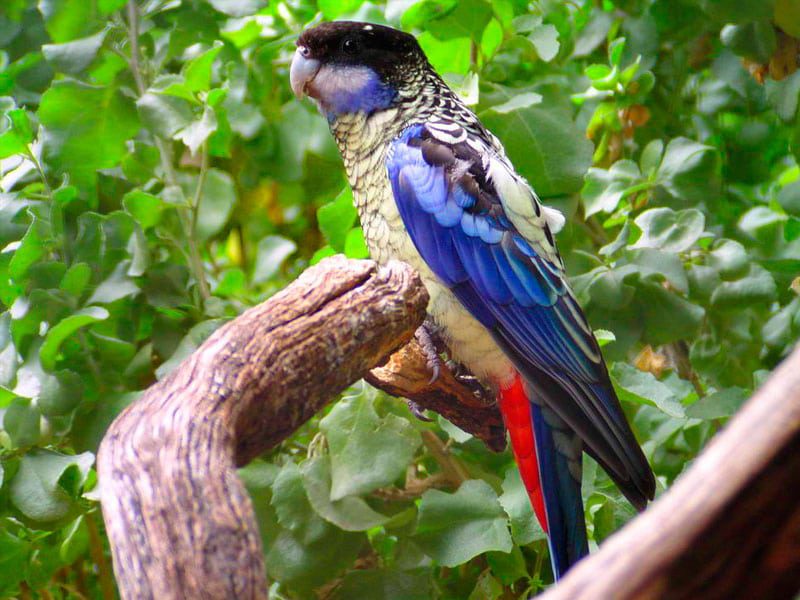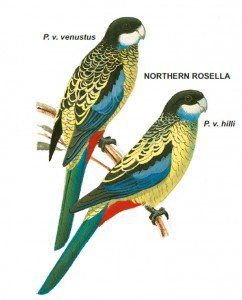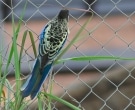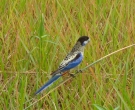Content
|
|---|
Description
28 cm.. length between 85 and 100 g. of weight.
The Northern Rosella (Platycercus venustus) they have a whitish beaks, black head, except the bottom of the cheeks and Chin that show a cream color. Their underparts feathers, lower back and rump, are pale yellow with black trim, giving these areas a look slightly flaky.
The curves of the wings are blue.
The subcaudales coverts are bright red. Nape, mantle and scapulars are black with broad yellow edges, forming an effect of shoulder straps. Blankets are black. The medium-sized coverts are bluish grey. The rest of the wing coverts are black with edges of yellow or blue grey. Deployed primaries are black. The Central tail feathers are verde-bronce while the outer feathers are dark blue with clear or white edges.
The females they are slightly smaller than the male, with the narrower peak.
The youth they are more turned off, with red markings on the head, and with more green and short tail feathers. Reaches it adult plumage in 12 months.
Subspecies description
-
(Mathews 1910) – Adults are similar to the nominal species but with bottoms scalloped with a sweeping black and the bottom of the cheeks of violet blue colour.
Platycercus venustus hilli
-
(Kuhl 1820) – The nominal.
Platycercus venustus venustus
Habitat:
The Northern Rosella they are unusual or are irregularly distributed in the mixed forests of eucalyptus and Melaleuca. They are generally found in open areas along rivers but are absent in floodplains along major rivers.. They are also present in the monsoon forests bordering open forests. From time to time, the Northern Rosella visit mangroves, parks and gardens in the vicinity of Darwin.
The Northern Rosella they live in pairs or in small groups ranging between 6 and 8 specimens. You rarely see them in flocks. They are usually very cautious and discreet, except in national parks where they are accustomed to human presence. They are more arboreal than other parrots of the genus habits Rosella. Funny Parrots are difficult to observe, whether on land or hidden in the foliage in the trees. They are most active in the morning and at the end of the afternoon. They show great caution when they come to drink at water points. When moving, their flight is fast, but unpredictable and less undulating than most parakeets.
Reproduction:
The nesting season extends from June to September, Sometimes a little earlier. The Northern Rosella install their nests in hole of a branch or the trunk of a tree cavity, generally in eucalyptus trees located a short distance from a stream. Implementation usually includes between 2 and 4 eggs that are incubated during 19 days. The female is solely in charge of incubation and is fed in the nest by her partner.. The chicks stay is relatively long and may last up to 7 weeks.
Food:
The Northern Rosella feed mainly on seeds of eucalyptus, acacia and Melaleuca Although they despise the of the blue cypress (Callitris intratropica). The seeds of green areas and nectar are also on their menu. The birds that live in the forests near the coast sometimes feed on the coast and along the banks of small streams.
Distribution:
Size of the area of distribution (reproduction / resident): 785.000 km2
Scattered through the coastal areas of the region of Kimberley, Western Australia, stretches of the North of the Northern Territory, and spreading over the border of Queensland at its eastern end.
The species is distributed from around Napier Ranges, in the Western region of Kimberley, to the East across the plateau of Kimberley and reaching the inside of Springvale. Next, crosses the border of the Northern Territory, extending with its southern limit along the victory river, inside, about Katherine, and along the McArthur river. It is also found throughout the nicholson river at the border of Queensland, and are distributed by a series of Islands on the coast including Koolan, Augusto, Coronation, Bathurst and Melville. Is occasionally in the suburbs of Darwin.
The species is generally rare throughout its range. The world's population is less of 50.000, and may that declining. A small number of captivity.
Fully protected by law.
Subspecies distribution
-
(Mathews 1910) – Kimberley Land Division of Western Australia to the East of the victory river, Northwest of the Northern Territory
Platycercus venustus hilli
-
(Kuhl 1820) – The nominal.
Platycercus venustus venustus
Conservation:
• Current category of the Red List of the UICN: Least concern
• Population Trend: Stable
The Northern Rosella they have a very unequal distribution. At most, they can be considered locally common, but in any part of their range they are evaluated as abundant.
Despite the studies that have been carried out since the 19th century, it is not possible to discern if the numbers are increasing or decreasing. It is possible that its population has always been limited, given the difficulty of finding refuge during the dry season.
Its population, according to some sources, It is estimated at around 50.000 specimens.
"Northern Rosella" in captivity:
Quite calm and shy. Incompatible con otras aves.
Not common in captivity, incluso en la avicultura de Australia
In terms of their longevity, una muestra, according to sources, lived 19,1 years in captivity
Alternative names:
– Northern Rosella, Brown’s Parakeet, Brown’s Rosella, Smutty Parakeet, Smutty Parrot, Smutty Rosella, White-cheeked Rosella (ingles).
– Perruche gracieuse, Perruche de Brown (French).
– Brownsittich, Brown Sittich, Brown-Sittich, Schwarzkopfsittich (German).
– Rosela-do-norte (Portuguese).
– Perico Gracioso, Rosela del Norte (español).
scientific classification:
– Order: Psittaciformes
– Family: Psittaculidae
– Genus: Platycercus
– Scientific name: Platycercus venustus
– Citation: (Kuhl, 1820)
– Protonimo: parrot charming
Images “Northern Rosella”:
Videos "Northern Rosella"
————————————————————————————————
“Northern Rosella” (Platycercus venustus)
Sources:
– Avibase
– Parrots of the World – Forshaw Joseph M
– Parrots A Guide to the Parrots of the World – Tony Juniper & Mike Parr
– Birdlife
– AnAge: The Animal Ageing and Longevity Database – An Age entry for Platycercus venustus
– Photos:
(1) – Platycercus – loros tipo Rosella – popugaychiki
(2) – Northern rosella taken in Litchfield National Park – A BRIEF DIGRESSION ON PARROTS
(3) – Alan Marshall’s Pictures of Northern Rosella (Platycercus venustus) in the NT (Northern Territory) of Australia
(4) – Alan Marshall’s Pictures of Northern Rosella (Platycercus venustus) in the NT (Northern Territory) of Australia
(5) – By TJ Lin from Taiwan (DSCN8954Uploaded by Snowmanradio) [CC BY-SA 2.0], via Wikimedia Commons
(6) – Rosellas, Northern – Princenton University Press







